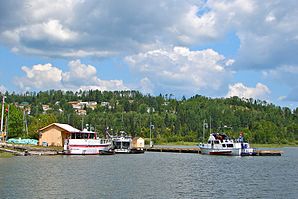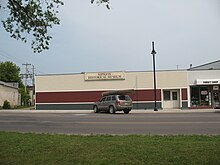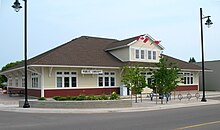Nipigon
| Nipigon | ||
|---|---|---|
 |
||
| Location in Ontario | ||
|
|
||
| State : |
|
|
| Province : | Ontario | |
| District : | Thunder Bay District | |
| Coordinates : | 49 ° 1 ′ N , 88 ° 15 ′ W | |
| Area : | 109.14 km² | |
| Residents : | 1752 (as of 2006) | |
| Population density : | 16.1 inhabitants / km² | |
| Mayor : | Richard Harvey | |
| Website : | www.nipigon.net | |
Nipigon is a township in the Canadian province of Ontario . It is located in the Thunder Bay District , at the northernmost point of Lake Superior on the west bank of the Nipigon River . The place is also south of Lake Helen and Lake Nipigon .
history
As with almost all places in Canada, Nipigon's history is fed by two sources, that of the First Nations and that of immigrants, especially Europeans. The oldest traces go back to around 7000 BC. BC back. Rock paintings from before the fur trade were found around the mouth of the Nipigon River .
In 1679, the French Claude Greysolon Dulhut established the first fur trading post, but in 1763 the British took over colonial rule. In 1850 they forced the local Anishinabe to sign a treaty, the Robinson Treaty . A four square mile reserve was created on the Gull River near Lake Nipigo on either side of the river. It was given to Chief Mishe-muckqua ( Mishi-makwa , "Big Bear").
In 1859 the Hudson's Bay Company (HBC) established the Red Rock Post trading post . In 1872, HBC expected the railway to be expanded and prepared for extensive construction work. Chief Trader Robert Crawford believed the Red Rock Post would be the railroad terminus. After these plans failed, the post became the main distribution center for goods in the lake catchment area. Steam boats coming from Lake Superior could dock at the harbor. In 1885, with the completion of the railway connection, a greater influx of settlers into the region began. The city's economic focus shifted from the lakeshore to Front Street. Later the trading post was called "Nepigon", then "Nipigon".
In 1898, the HBC moved its trading post to the Canadian Pacific Railway station , which fell victim to a fire in 1924. The rebuilt trading post existed until 1999. In 1908 the settlement was incorporated and the following year the first mayoral elections took place. Settlers settled in the so-called "Mudflats" near the river, who lived mainly from fishing, hunting and a little cattle breeding until 1953, when they had to give way to a plan for "development".
In 1990, part of the local museum's collection was destroyed by fire, but most of the photos in the collection that EC Everett's widow donated to the museum after her husband's death in 1984 survived .
On February 6, 2007, the wood processing plant of Multiply Forest Products , which was the largest employer in the region with over 100 employees, burned down . A few weeks earlier, the employees had bought the company from the owner, Columbia Forest Products , which is based in Portland , Oregon .
population
Nipigon had 2338 inhabitants in 1991 and 2210 in 1996. Since then the population has been shrinking rapidly. In 2001 only 1964 people lived in the place, in 2006 there were 1752. In addition, the median rose from 39.5 to 43.8, which reflects the strong aging of the formerly young population. In addition, the economic slump reduced average household income by CAD 9,300 to CAD 49,163.
traffic
Nipigon forms a bottleneck in the east-west connection in Canada. East of the city only two bridges cross the Nipigon River, a single-track railway bridge from 1885, and a two-lane road bridge from 1937. The two highways 11 and 17 and the two railway routes run over this bottleneck. The road towards Sault Ste Marie (Highway 17) was not completed until 1961. Highway 11, which connects the region with Toronto in a wide arc, leads north . It is heavily burdened by long-distance truck traffic.
Museum and library
Nipigon has its own historical museum, which is mostly dedicated to the history of the Euro-Canadians. It is difficult to find out anything about the local Anishinabe groups.
Web links
Remarks
- ↑ GREYSOLON DE LA TOURETTE, CLAUDE , Dictionary of Canadian Biography.


